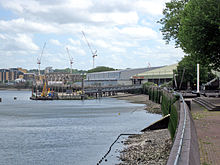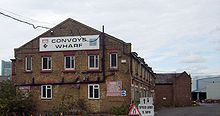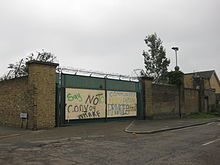- Convoys Wharf
-
Convoys Wharf, formerly called the King's Yard,[1] is the site of Deptford Dockyard, the first of the Royal Dockyards, built on a riverside site in Deptford, by the River Thames in London. It was first developed in 1513 by Henry VIII to build vessels for the Royal Navy. Convoys Wharf also covers most of the site of Sayes Court manor house and gardens,[2] home of diarist John Evelyn. The site was owned until 2008 by News International, which used it to import newsprint and other paper products from Finland until early 2000. It is now owned by Hutchison Whampoa Limited and is subject to a planning application to convert it into residential units,[3] though it has safeguarded wharf status.[4]
Contents
History
Royal Dockyard
The King's Yard was established in 1513 by Henry VIII as the first Royal Dockyard building vessels for the Royal Navy, and the leading dockyard of the period.[5][6] It brought a large population and prosperity to Deptford.[7]
The docks are also associated with the knighting of Sir Francis Drake by Queen Elizabeth I aboard the Golden Hind,[8] the legend of Sir Walter Raleigh laying down his cape for Elizabeth,[9] Captain James Cook's third voyage aboard Resolution,[10] Frobisher’s and Vancouver’s voyages of discovery, despatching ships against the Spanish Armada,[11] as well as for Nelson’s battles including Trafalgar.[12]
In 1698 Tsar Peter I of Russia aged 25, came to Deptford to learn about shipbuilding and seamanship. He was granted the use of John Evelyn’s Sayes Court, adjoining the Royal Dockyard, by William III. In three months he and his party caused considerable damage to the famous[13][14] gardens, and also to the house, with "much of the furniture broke, lost or destroyed". Sir Christopher Wren was instructed to survey the property and declared it "entirely ruined".[15] At the mouth of Deptford Creek, on the Fairview Housing estate, there is a statue, designed by Mihail Chemiakin and gifted by Russia commemorating Peter's visit.
18th Century and Closure
By the 18th century, due to the silting of the Thames, the dockyard's use was restricted to ship building and distributing stores to other yards and fleets abroad. It was shut down from 1830 to 1844[5] and in 1864 a Parliamentary Committee recommended that the dockyards at Deptford (and Woolwich) should be closed. Their recommendation was accepted and the Deptford dockyard was closed in May 1869,[16] by which time it employed 800 people. It had produced some 450 ships, the last being the wooden screw corvette HMS Druid launched in 1869.[7]
Foreign Cattle Market
Before refrigeration cattle had to be imported alive, and the Contagious Diseases (Animals) Act 1869 gave the City of London Corporation exclusive local authority for foreign animal imports and processing subject to its opening a market before January 1872. The site at Deptford was acquired and the market opened in 1871,[17] and by 1889 the original site had been extended to 27 acres. In 1907 at its peak, 184,971 cattle and 49,350 sheep were imported through the market but by 1912 these figures had declined to 21,547 cattle and 11,993 sheep.[18]
During the War years
The Foreign Cattle Market was taken over by the War Department in 1914, on a tenancy agreement from the City of London Corporation, for use as the Royal Army Service Corps Supply Reserve Depot.[17] On several occasions after the Armistice traders and others urged that the market should be reopened, however in 1924[19] the War Office exercised their option to buy it [18][20] along with the adjacent the Sayes Court property for £400,500 (£17.2 million as of 2011),[21] under deeds dated 25th March 1926, 18th March 1927 & 25th July 1927 including the railway, tramway, wharfage and jetty rights and easements.[17]
The yard also served as a United States' Advance Amphibious Vehicle base and married quarters during the Second World War.[12][22]
Latter part of 20th Century
The site lay unused until 1980 when it was purchased by News International from the UK Ministry of Defence for £1,600,000 (£5.11 million as of 2011),[21], and a remainder in 1986, for £340,000 (£743 thousand as of 2011),[21].[23] In 1993 the Greenwich and Lewisham (London Borough Boundaries) Order transferred the site from the London Borough of Greenwich to the London Borough of Lewisham.[24]
Archaeology
Most of the Tudor, Stuart, Georgian and Victorian structures above ground level that had survived until 1955 have since been destroyed. One structure that escaped the demolition is Olympia Warehouse, a unique cast-iron building constructed in the 1840s.[25] However archaeological surveys carried out by CgMs and Pre-Construct Archaeology in 2000 by Duncan Hawkins, in 2000 by Jon Lowe and in 2001 by David Divers, established that by far the greater part of the dockyard survives as buried structures filled in intact between 1869 and 1950. The structures of the yard proper, the docks, slips, basins, mast ponds, landing places and stairs, constitute a substantial architectural fabric that is currently extant, though largely invisible, being covered by superficial accretion or infill.[12] As yet there has been no archaeological investigation of the garden area of Sayes Court, and only limited trial trenching of part of the manor house.[26]
Sayes Court
Main article: Sayes CourtThe War Department hired the Sayes Court area and almshouses, from the City of London Corporation from the 19th September 1914 to use as a Horse Transport Reserve Depot at a rental of £90 per annum (£6.4 thousand as of 2011),[21][17] to enlarge its Supply Reserve Depot at the Foreign Cattle Market.[27]
The fee simple of the Foreign Cattle Market and of the Sayes Court property were purchased by the War Department, for £400,500 (£17.2 million as of 2011),[21] under deeds dated 25th March 1926, 18th March 1927 & 25th July 1927 including the railway, tramway, wharfage and jetty rights and easements.[17]
Dockyard Railways
From 15 December 1900 there was tramway access via Grove Street, to the Foreign Cattle Market, using their own Maudslay petrol locomotive. When the docks became an army depot the junction was relaid to standard gauge for direct connection to the LB&SCR.[28] There was as well, an internal narrow gauge tramway system. When the War Department took over, they introduced steam locomotives to work the tramways,[29][30] purchasing between 1915 and 1917, twelve oil-fired Warril type 18 in (457 mm) gauge locomotives from the Hunslet Engine Company.[31] In December 1920 the Government announced the sale of the equipment from the railway at the Deptford Meat Depot. In 1921 Sir Robert Walker purchased three locos and 75 wagons for the Sand Hutton Light Railway, and purchased a fourth 1927. By January 1938 of the remaining eight locos, seven were apparently still in existence at Deptford, but out of use.[29]
Planning application
In 2002 News International applied to the London Borough of Lewisham for outline planning permission to erect 3,500 residential units on the site. Lewisham councillors resolved to approve the application in May 2005. As of July 2008 the application had yet to be referred to Mayor of London Boris Johnson. The Mayor has the power to direct a refusal of planning consent and if the matter is ever referred will probably direct a refusal.[citation needed]
 The Thames Path interrupted by Convoys Wharf
The Thames Path interrupted by Convoys Wharf
If the Mayor allows the application it will then be referred to the Secretary of State for Communities and Local Government. Reasons for such a referral would include a Government direction that half the site is safeguarded for freight use. Since freight wharves on the Thames were safeguarded in 1997 by the then Secretary of State for the Environment, John Gummer, only one operational wharf has been lost to residential use without a full public inquiry. This was Delta/Blackwall Wharf, a major aggregates wharf redeveloped as part of the Greenwich Peninsula masterplan.[citation needed]
On 18 May 2005 a 50/50 joint venture company of Cheung Kong Holdings and Hutchison Whampoa entered into an agreement to acquire Convoys Wharf, to develop it as a mixed residential and commercial project.[32] In 2008 a new planning application was submitted by Hutchison based largely on the original Richard Rogers scheme.[33]
The Grade II listed Olympia Warehouse will have to be preserved and refurbished as part of the redevelopment of the site.[25]
Protest
In October 2000, 'Creekside Forum' set up the 'Convoys Opportunity' umbrella group in response to the News International Ltd plan to sell the 40-acre (160,000 m2) Convoys Wharf site.[34] Convoys Opportunity, composed of community organisations, churches, businesses and others in Deptford and beyond,[35] campaigned to have the News International scheme refused and the safeguarding order upheld.
In 2011 a group of local residents came together voiced by the blog Deptford is ... to try to ensure that the development is for the best of Deptford.[36]
References
- ^ "Samuel Pepys diary entry for 22 Aug 1665". Pepysdiary.com. http://www.pepysdiary.com/archive/1665/08/22/index.php. Retrieved 2010-05-01.
- ^ Google Earth .kmz file overlaying Evelyn's map of 1653 with the modern street map.
- ^ "Rogers Stirk Harbour + Partners "Convoys Wharf Conception"". Richardrogers.co.uk. 2004-12-15. http://www.richardrogers.co.uk/render.aspx?siteID=1&navIDs=1,4,25,124,125. Retrieved 2010-05-01.
- ^ safeguarded_wharves_05.pdf
- ^ a b "National Maritime Museum Research guide B5: Royal Naval Dockyards". Nmm.ac.uk. http://www.nmm.ac.uk/researchers/library/research-guides/the-royal-navy/research-guide-b5-royal-naval-dockyards. Retrieved 2010-05-01.
- ^ "Deptford and Woolwich: London's Royal Dockyards - The working Thames". Port Cities. http://www.portcities.org.uk/london/server/show/ConNarrative.52/chapterId/774/Deptford-and-Woolwich-Londons-Royal-Dockyards.html. Retrieved 2010-05-01.
- ^ a b london-footprints.co.uk Deptford Dockyard
- ^ Sir Francis Drake: The Queen's Pirate, pp 218-19, H Kelsey, Yale University Press (1 Sep 2000), ISBN 0-300-08463-3
- ^ Sir Walter Ralegh and the Quest for El Dorado, pages 83 & 176, Marc Aronson, Clarion Books (April 17, 2000), ISBN 0-395-84827-X
- ^ Captain James Cook, pp 273-294, Richard Hough, W.W.Norton (17 Aug 1996), ISBN 0-393-31519-3
- ^ Deptford and the Armada by Thankful Sturdee, The Times, 3 September 1888, p. 10, Col. B
- ^ a b c Greenwich Industrial History Proposal to list the remains of the Royal Dockyard at Deptford 6 January 2010
- ^ "Deptford, St Nicholas, The Environs of London: volume 4: Counties of Herts, Essex & Kent (1796) by Daniel Lysons, pp. 359-385". British-history.ac.uk. 2003-06-22. http://www.british-history.ac.uk/report.aspx?compid=45482. Retrieved 2010-05-01.
- ^ The Charm of Sayes Court, John Evelyn as Garden Architect by W. G. Hiscock, The Times, 11 August 1952, p.2, col E
- ^ Calendar of Treasury Books, 1697–1702, 158–9
- ^ Handbook to the Environs of London by James Thorne, John Murray, Albemarle Street, 1876
- ^ a b c d e Supply Reserve Depot, Deptford. (Old Foreign Cattle Market). Skeleton Record Plan. Sheet No. 1 of a set of 4. Corrected to September 1938.
- ^ a b Sale of Deptford Market. Government to Pay £387,000. The Times, 13 March 1926, p.12, col F
- ^ or 1926-27 according to the Supply Reserve Depot, Deptford. (Old Foreign Cattle Market). Skeleton Record Plan. Sheet No. 1 of a set of 4. Corrected to September 1938.
- ^ Future of Deptford Market. War Office decision to buy. The Times, 6 February 1924, p12, col B
- ^ a b c d e UK CPI inflation numbers based on data available from Lawrence H. Officer (2010) "What Were the UK Earnings and Prices Then?" MeasuringWorth.
- ^ PRO Works 43/614-6
- ^ Land Registry
- ^ "The Greenwich and Lewisham (London Borough Boundaries) Order 1993". Opsi.gov.uk. http://www.opsi.gov.uk/SI/si1993/Uksi_19931276_en_1.htm. Retrieved 2010-05-01.
- ^ a b Convoys Wharf London, Richard Rogers Partnership, 2002
- ^ CVW00, Convoys Wharf evaluation by CgMs Consulting on behalf of News International PLC by David Divers
- ^ Lewisham past and present, by John Coulter, Sutton Publishing, 2001
- ^ London Bridge to East Croydon byVic Mitchell and Keith Smith, Middleton Press
- ^ a b Hartley K.E. (1964). The Sand Hutton Light Railway. The Narrow Gauge Railway Society.
- ^ The 18 in (457 mm) gauge is listed at Railroad Gauge Width as also having been used at Woolwich Arsenal, Chatham Dockyard, Crewe Locomotive Works and Horwich Locomotive Works
- ^ 18 Inch Gauge Steam Railways by Mark Smithers
- ^ http://notice.singtao.com/ADMA/00013/epdf/2140405-CKH-PA(e)5555.pdf
- ^ "Mothballed £700m Deptford housing scheme on track". Building. 2009-11-06. http://www.building.co.uk/story.asp?sectioncode=29&storycode=3152565&c=1. Retrieved 2010-05-01.
- ^ London Snoring at Creekside Forum News 1 August 2007
- ^ Select Committee on Transport Written Evidence, Memorandum by the Creekside Forum (TT 09) by Bill Ellson, Creekside Forum, July 2004
- ^ Deptford is ...
Further reading
- An archaeological desk-based assessment, by Duncan Hawkins, CgMs Consulting, April 2000
- Preliminary Assessment of Surviving Historic Fabric Convoy’s Wharf, Deptford, June, 2000 by Jon Lowe
- Convoys Wharf, Deptford; TQ 3700 7820; (David Divers); evaluation; 9 October-14 November 2000; CgMs Consulting on behalf of News International PLC; CVW00
- An archaeological field evaluation (trial trenching) in consultation with English Heritage, by David Divers, CgMs Ltd., January, 2001
- Our Future Heritage: A Framework for the Management of The Heritage Resource, Convoys Wharf, Deptford, London Borough of Lewisham. ,English Heritage, October 2003
- London Snoring: A tale of missed opportunity Creekside Forum, Spring 2007
External links
- Convoys Wharf development website
- Lewisham Unitary Development Plan 2004, Schedule 3 – Areas of Archaeological Priority protected by Policy URB 21 Archaeology and shown on the Proposals Map
- No more penthouses News Shopper, Lewisham & Greenwich, 17 May 2005
- New look for old wharf News Shopper, Lewisham & Greenwich, 31 May 2005
- Include tribute in wharf scheme News Shopper, Lewisham & Greenwich, 19 July 2005
- Convoys Wharf, Deptford at GLIAS Notes and news, December 2009
- Safeguarded Wharves - the official 2005 list and descriptions
- Model of the Royal dockyard at Deptford in 1774
Categories:- Archaeological sites in London
- Buildings and structures in Lewisham
- Docks in London
- Military history of London
- Ports and harbours of the Thames Estuary
- Redeveloped ports and waterfronts
- Redevelopment projects in London
- Royal Navy bases in England
- Royal Navy dockyards in England
- Shipbuilding in London
- Town and country planning in the United Kingdom
- History of Lewisham
- Thames Path
- Shipyards on the River Thames
- Port of London
- Wharves
- 18 inch gauge railways
- Industrial railways in England
- Rail transport in London
- Narrow gauge railways in England
Wikimedia Foundation. 2010.




